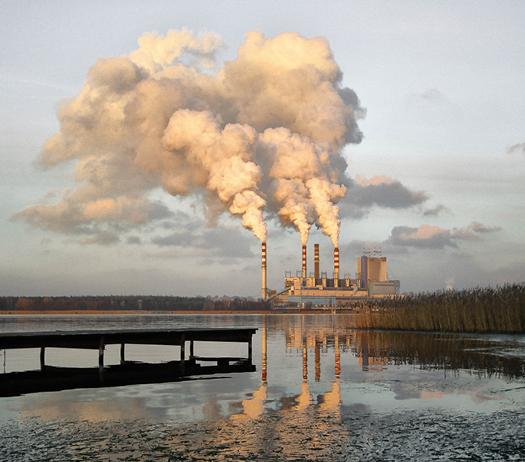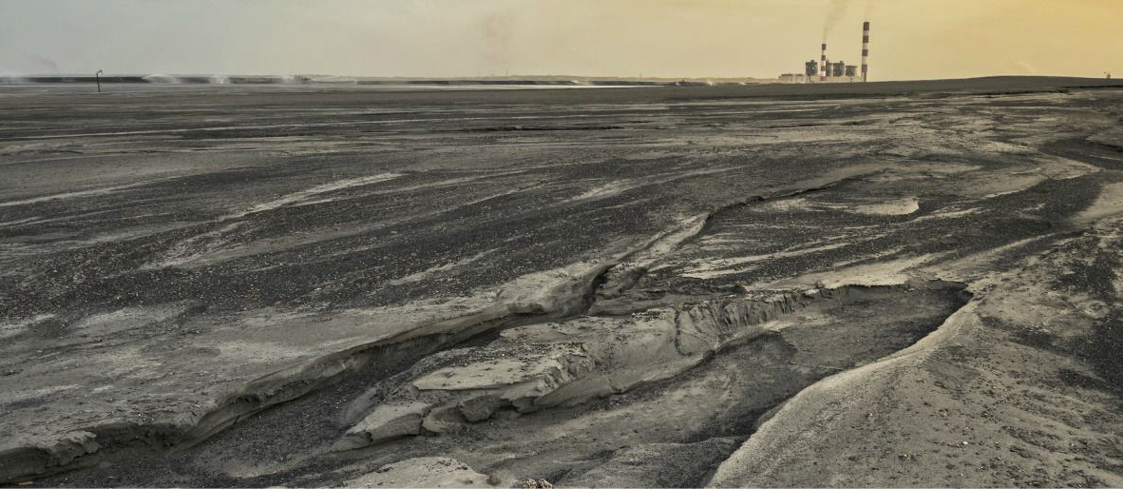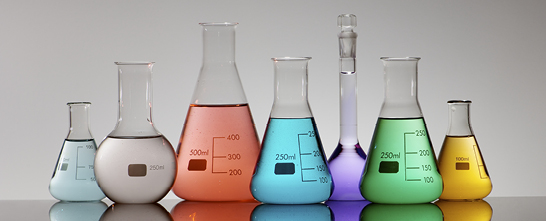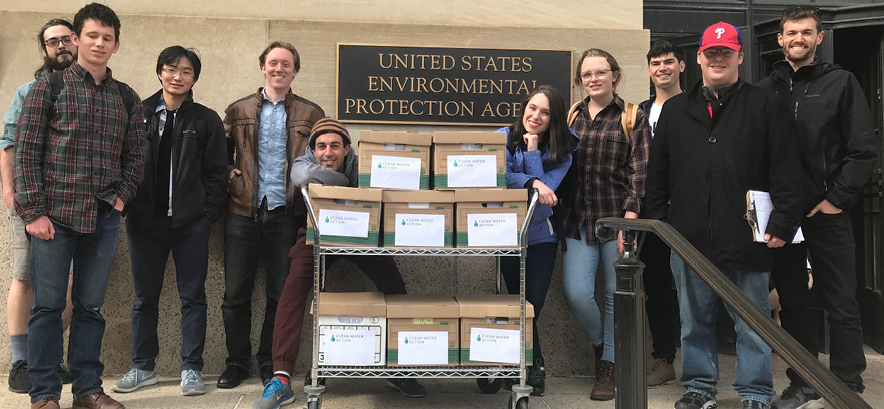In This Issue:
- The Water Polluter Loophole
- Sacrificing Colorado's Groundwater
- Reforming our Democracy
- Court Rules to Protect Clean Water
- The Forever Chemical
- Rejecting the Dirty Water Rule
- Download the PDF version of this newsletter
EPA’s Latest Water Polluter Loophole
In April, the U.S. Environmental Protection Agency (EPA) announced it will no longer regulate pollution in rivers, lakes, streams, and bays if that pollution first travels through groundwater. Despite having required permits for this type of pollution for decades, EPA now claims it doesn’t have authority to do so, and that their new interpretation is the “only reading of the Clean Water Act.” We don’t agree, and neither do several circuit courts.
EPA’s decision ignores the plain language of the Clean Water Act — which clearly prohibits unpermitted dumping of pollution, whether that pollution reaches a river through a concrete pipe or through groundwater. That’s because it doesn’t make sense for the Act to cover pollution dumped from a pipe into a river that flows through groundwater, but not pollution that flows through groundwater into that same river. Different routes of pollution shouldn’t be treated differently when the end result is the same.

Animal waste lagoons, mining waste, coal ash ponds, sewage injection wells, and other harmful pollution sources can all contaminate surface waters by way of groundwater first. Because of this, both the Fourth and Ninth Circuit Court of Appeals have concluded that, although the Clean Water Act does not regulate groundwater itself, there’s nothing in the Act to prevent EPA from requiring permits for pollution that travels through groundwater before reaching a river or other surface water.
EPA is blasting open a loophole to benefit heavy polluting industries at the expense of public health and our nation’s water quality. Polluters could find new, nefarious ways to dispose of their pollution without a Clean Water Act permit, for instance by injecting waste into an aquifer that flows into a nearby river. In order to protect our nation’s waters, EPA must continue to hold polluters accountable for dumping chemicals and other pollutants into groundwater when those pollutants also contaminate rivers, lakes, and bays.
EPA is collecting public comments on its decision until Friday, June 7th. Please join Clean Water Action in telling EPA to immediately withdraw its pro-polluter scheme that would allow industries to launder their dangerous pollution through groundwater in order to avoid getting a Clean Water Act permit. You can take action here.
Colorado Groundwater At Risk from Oil and Gas Injection
The aquifer exemption program in the Safe Drinking Water Act (SDWA) Underground Injection Control (UIC) program allows certain oil and gas and mining activity to occur in groundwater that would otherwise be protected as a potential drinking water source. The latest Clean Water Action report on aquifer exemptions exposes how Colorado may be failing to protect drinking water sources from injection due to poor implementation of the aquifer exemption program.
Despite the high stakes of sacrificing potential drinking water for the sake of fossil fuel development, aquifer exemption programs at both the state and federal levels have suffered from inadequate funding and poor implementation. Aquifer exemptions have played a significant role in the growth of U.S. oil and gas production, eliminating the regulatory protections for groundwater that would otherwise slow or stop drilling.
Clean Water Action’s work examining state and federal aquifer exemption programs pushed the U.S. Environmental Protection Agency (EPA) to increase oversight, including the creation of the first-ever inventory and map of exemptions across the country. This increased transparency has enabled new analysis and scrutiny of state aquifer exemption programs. This analysis examines aquifer exemptions in Colorado associated with oil and gas injection activity, building on our existing body of work investigating and advocating for aquifer exemption reform in California, Texas, Oklahoma and at EPA.
• We identified several reasons for concern with Colorado’s aquifer exemption program, including:
• Available data on the more than 900 injection wells in Colorado is incomplete and hard for the public and regulators to access.
• A lax approval process for aquifer exemptions fails to require adequate public participation and review
• The majority of the nearly 300 existing exemptions do not appear to be based on actual geologic conditions, and instead reflect fixed radius or rectangular designations based on where injection wells are located.
• The state does not even keep an inventory of exemptions, and EPA’s accounting is full of data gaps and inaccuracies such as imprecise locations, lack of formation water quality information, or no information on the thickness of the injection zone.
We concluded that in order to adequately protect underground sources of drinking water (USDWs) in Colorado, regulators must apply greater oversight to this program, beginning with improved data management and enhanced geologic review of exempted aquifers. Read the report here.
Court Orders EPA to Strengthen Power Plant Water Pollution Standards
In April, the Fifth Circuit Court of Appeals ruled that the U.S. Environmental Protection Agency (EPA) must strengthen its 2015 water pollution standards for coal-fired power plants. Power plants dump more toxic wastewater into our nation’s surface waters than any other industry, and their pollution has resulted in thousands of river miles being unsafe for swimming or fishing. Prior to 2015, water pollution limits for coal plants had not been updated since 1982. Clean Water Action and our allies strongly supported the rule’s requirements for power plants to modernize their wastewater treatment technologies, even though we believed EPA should have issued even stronger standards.

This court decision is a huge victory for environmental groups who challenged the 2015 EPA rule for exempting so-called “legacy wastewater” (toxic wastewater stored in coal ash ponds), as well as leachate from coal ash ponds and landfills. The Court rejected EPA’s numerous excuses for its exemptions, holding the agency acted unlawfully for allowing power plants to continue to use coal ash ponds as the only “technology” to treat certain waste streams, as EPA’s last update to these standards in 1982 had done. Using an analogy to other 1982-era technologies, the court said, "it was as if Apple unveiled the new iMac and it was a Commodore 64."
Despite this court order, EPA is still planning to publish a new proposed rule this summer to further weaken the 2015 standards. At the behest of the power plant industry, EPA wants to roll back pollution safeguards for two of the largest and most toxic waste streams—bottom ash waste water and toxic scrubber sludge. This plan is especially troubling because many of these plants dump their toxic wastewater directly upstream of drinking water intakes, putting public health at risk. It is unfair for drinking water systems to bear the burden of cleaning up this polluted water so they can deliver safe water to their customers.
Clean Water Action will continue to push back against EPA’s illegal scheme to gut these pollution safeguards. Affordable treatment technologies exist today that could easily eliminate all of this water pollution. We believe power plants should be responsible for cleaning up all of their pollution, not just some of it.
Making Democracy Work: H.R. 1
Why do so many Members of Congress stand by — or, even worse, pile on — whenever the Trump Administration advances another one of its reckless anti-environment giveaways to big polluters?
It might be because things have been systematically rigged to boost the influence wielded by big polluters and other corporate special interests. When people who care about clean water, clean air, and the health of our communities are effectively shut out — or worse, ignored by those elected to represent us — bad things can happen.
The Trump Administration’s Water Polluter Loophole (cover story) and Dirty Water Rule (page 6) are perfect examples. These schemes would cut even more deeply into fundamental Clean Water Act protections for the nation’s water. The Trump administration is attempting to systematically weaken the Clean Water Act, like pulling just enough blocks out of the Jenga so the entire tower collapses. They have been able to do it with very little interference from Congress.
Polluters and their allies in Congress and state legislatures have worked for years to make it harder for people to vote. They’ve redrawn political districts to make it difficult to unseat elected officials who put corporate donors before their constituents. They’ve opened the floodgates to virtually unlimited special interest political money and warmly embraced big money lobbying from the same corporate interests, now at record breaking levels. It’s no wonder their Dirty Water agenda has gotten as far as it has, so quickly.

That’s why Making Democracy Work has been central to Clean Water Action’s mission for more than four decades. While we fight to defend clean water from outrageous attacks in Congress and now even at the Environmental Protection Agency (EPA), Clean Water Action is redoubling its commitment to democracy. For the first time in years, thanks to big changes brought by last year’s midterm elections, there is now a package of bills before Congress that attacks the root causes of this serious, systemic problem.
Clean Water Action and allied environmental and conservation organizations are campaigning together to build support for H.R. 1, which was passed by the U.S. House this spring. This bill would make it easier — not harder — for people to exercise their constitutional right to vote. It tackles the problem of money in politics head on. It would help bring an end to gerrymandered districts drawn to protect the incumbents, and remove partisan politics from the process. It would also tighten ethical standards for government and help close the revolving door which has placed industry hacks in charge at EPA and rewards polluter-friendly officials with industry jobs when they leave public service.
Here’s a little more on good government and pro-democracy reforms in H.R.1:
• Voting rights and fair elections for every American: Automatic voter registration, ending partisan gerrymandering, expanded early voting, re-enfranchising people with felony convictions, ramping up election security, and a federal holiday for Election Day.
• A democracy that puts people first, not money: Small-donor citizen-funded elections (not corporate special interest-funded elections) so lawmakers don’t have to rely on Big Money, full disclosure of political spending, and stronger oversight to make sure our rules are actually enforced.
• Ethical government that’s accountable to the people: Closing the revolving door in Washington, stopping conflicts of interest, banning lawmakers from serving on corporate boards while in office, and requiring presidential candidates to disclose their tax returns.
The bill is waiting for a hearing in the Senate. Americans need to convince Mitch McConnell and Senate leadership to bring H.R.1 up. You can do that here. This is an uphill battle but it is essential for the future of our clean water movement, the restoration of democratic norms and a civil society where the voices of everyday people will actually count for something.
Taking On PFAS — the Forever Chemicals
PFAS is a class of human-made chemicals which includes Per- and Polyfluoroalkyl substances. These chemicals are very long-lived, which means that they remain in the environment and in humans and wildlife for a very long time. There is increasing concern about PFAS chemicals, which are found in low levels in the blood of most Americans and in people around the world. PFAS chemical pose human health risks, including reproductive and immune system affects and cancer.

Clean Water Action is working in states and at the national level to take on PFAS chemicals. Most importantly, we need to know what these chemicals are, how they are used, and how they are getting into the environment so that we can stop their continual release. We need to clean up the mess that has already been made, including at contaminated sites and in our drinking water sources. And we need to hold polluters accountable for the costs of cleaning up these chemicals.
As of press time, numerous bills are being introduced in the U.S. House and Senate to address PFAS chemicals. And in February, the Environmental Protection Agency (EPA) released a “PFAS Action Plan” that summarized ongoing activity, affirmed commitments the agency made in May 2018, and announced several new initiatives. EPA has been and continues to be conducting a great deal of research and other activity around PFAS chemicals. The agency also announced several initiatives around developing new analytical methods, restricting new uses of PFAS chemicals, and using a variety of enforcement authorities to address PFAS contamination issues. EPA will also begin the Safe Drinking Water Act limits- setting process for two chemicals — PFOA and PFOS — and evaluate whether new information supports setting limits for more PFAS chemicals. The agency also committed to improving analytical methods and to increased monitoring for more PFAS chemicals in drinking water.
Clean Water Action is urging EPA to move as quickly as possible to protect the most people from the most PFAS exposure as soon as possible. EPA has the authority and should take more concrete actions to make progress on getting PFAS chemicals out of the environment. For example:
We don’t even know all the PFAS chemicals in use: EPA should develop, publish and regularly update a database of known and active PFAS. Communities and officials need to know where chemicals are manufactured, processed.
Drinking water initiatives must be accelerated: EPA must commit resources to the most robust research plans and other activity related to drinking water.The ability to find PFAS chemicals in drinking water, to set appropriate limits and to treat water to achieve those limits is of the utmost importance and the Plan does not indicate whether EPA will be able to meet widespread public expectations for results. EPA should also be taking concrete steps to advance the scientific research needed to address PFAS chemicals as a class, and not one by one.
Scientific Capacity as Infrastructure: EPA and other federal agencies can help us improve our ability to detect PFAS chemicals in the environment. This includes not only the analytical methods to do so, but the actual certified laboratories to conduct the testing. We need to think of these tools as “water infrastructure” and huge strides are needed so that we can detect contaminants and protect people and our life support systems.
More than Half a Million People Reject Trump’s Dirty Water Rule
Despite a ridiculously short 60-day comment period, nearly 525,000 people submitted comments opposing EPA’s proposal to eliminate Clean Water Act protections for many streams and over half of our nation’s wetlands. And it isn’t just clean water advocates and environmental organizations who oppose these dangerous rollbacks — many tribal nations, states, numerous scientists, business owners, faith leaders, and more—all submitted comments asking EPA not to gut these critical safeguards.
Tribal nations and states who oppose the Dirty Water Rule are concerned they lack the staff and resources to protect streams and wetlands absent strong federal regulations. Dozens of states have limits on their ability to pass regulations stricter than what EPA requires. And since nearly every state has water from another state flowing into it, even if a state downstream passes its own strong clean water protections, those safeguards could be undermined by a state upstream with weaker protections. Eliminating strong Clean Water Act protections that have been on the books for decades not only defies common sense, it puts our public health and economy at risk.
Scientists called out the administration’s hypocrisy for acknowledging the ecological and scientific value of streams and wetlands, all while proposing to strip these valuable resources of protections. Eliminating protections for these vital water bodies will increase the risk of floods, drinking water contamination, and harm to the places where people swim and fish. That’s because small streams impact the water quality of larger rivers; allowing more pollution in small streams will result in more pollution flowing into downstream waters. Wetlands can absorb floodwaters, so allowing them to be filled or destroyed will put communities at increased risk from flooding.
Though the official comment period on the Dirty Water Rule is now closed, the fight to protect streams and wetlands is far from over. More than 75,000 Clean Water Action supporters told EPA to drop its proposal and we are committed to doing everything we can to ensure the Dirty Water Rule is eventually eliminated for good. Clean Water Action believes EPA’s gutting of clean water safeguards is illegal, and will continue to challenge these rollbacks in court.

